Effect of Rice Residue Retention and Foliar Application of K on Water Productivity and Profitability of Wheat in North West India
Abstract
1. Introduction
2. Materials and Methods
2.1. Experimental Site
2.2. Experiment and Field Management
2.3. Climate at the Experimental Site
2.4. Treatment Imposition
2.5. Measurements on Yield and Yield Attributes.
2.6. Measurement of Water Productivity and Physiological Traits.
2.7. Economics
2.8. Statistical Analysis
3. Results
3.1. Analysis of Variance of Treatments
3.2. Effect of Residue Retention on Wheat Yield, Yield Parameters, WUE, and Economic Returns
3.3. Effect of Foliar Application of K on Wheat Yield, Yield Parameters and WUE
3.4. Effect of Foliar Application of K on Revenue
3.5. Interaction Effect of Treatments on Yield and Profitability of Wheat
3.6. Correlation and Regression Analysis
3.7. Impact of Residue Retention on Economy and Environment
4. Discussion
Economic and Environmental Impact
5. Conclusions
Author Contributions
Funding
Acknowledgments
Conflicts of Interest
References
- Sharma, I.; Tyagi, B.; Singh, G.; Venkatesh, K.; Gupta, O. Enhancing wheat production—A global perspective. Indian J. Agric. Sci. 2015, 85, 3–13. [Google Scholar]
- Gupta, R.K.; Naresh, R.K.; Hobbs, P.R.; Jiaguo, Z.; Ladha, J.K. Sustainability of post-green revolution agriculture: The rice-wheat cropping systems of the Indo-Gangetic Plains and China. Improv. Product. Sustain. Rice-Wheat Syst. Issues Impacts 2003, 65, 1–25. [Google Scholar]
- Ladha, J.K.; Fischer, K.; Hossain, M.; Hobbs, P.; Hardy, B. Improving the Productivity and Sustainability of Rice-Wheat Systems of the lndo-Gangetic Plains: A Synthesis of NARS-IRRI Partnership Research. IRRI Discussion Paper; 40; IRRI: Los Banos, PL, USA, 2000; p. 31. [Google Scholar]
- Timsina, J.; Connor, D.J. Productivity and management of rice–wheat cropping systems: Issues and challenges. Field Crop. Res. 2001, 69, 93–132. [Google Scholar] [CrossRef]
- Goi, M. 3rd Advance Estimates of Production of Major Crops for 2018-19. Available online: https://pib.gov.in/Pressreleaseshare.aspx?PRID=1573283 (accessed on 4 March 2020).
- National Academy of Agricultural Sciences. Innovative Viable Solution to Rice Residue Burning in Rice-Wheat Cropping System Through Concurrent Use of Super Straw Management System-Fitted Combines and Turbo Happy Seeder; Policy Brief No. 2; National Academy of Agricultural Sciences: New Delhi, India, 2017; pp. 1–16. [Google Scholar]
- Jain, N.; Bhatia, A.; Pathak, H. Emission of air pollutants from crop residue burning in India. Aerosol Air Qual. Res. 2014, 14, 422–430. [Google Scholar] [CrossRef]
- Moefc, G. India: Second Biennial Update Report to the United Nations Framework Convention on Climate Change. Available online: https://pib.gov.in/Pressreleaseshare.aspx?PRID=1557609 (accessed on 16 March 2019).
- Shyamsundar, P.; Springer, N.P.; Tallis, H.; Polasky, S.; Jat, M.L.; Sidhu, H.S.; Krishnapriya, P.P.; Skiba, N.; Ginn, W.; Ahuja, V.; et al. Fields on fire: Alternatives to crop residue burning in India. Science 2019, 365, 536–538. [Google Scholar] [CrossRef]
- Chakrabarti, S.; Khan, M.T.; Kishore, A.; Roy, D.; Scott, S.P. Risk of acute respiratory infection from crop burning in India: Estimating disease burden and economic welfare from satellite and national health survey data for 250,000 persons. Int. J. Epidemiol. 2019, 48, 1113–1124. [Google Scholar] [CrossRef] [PubMed]
- Cusworth, D.H.; Mickley, L.J.; Sulprizio, M.P.; Liu, T.; Marlier, M.E.; DeFries, R.S.; Guttikunda, S.K.; Gupta, P. Quantifying the influence of agricultural fires in northwest India on urban air pollution in Delhi, India. Environ. Res. Lett. 2018, 13, 044018. [Google Scholar] [CrossRef]
- Sharma, M.; Dikshit, O. Comprehensive study on air pollution and green house gases (GHGs) in Delhi; IIT: Kanpur, India, 2016; p. 334. [Google Scholar]
- Bhuvaneshwari, S.; Hettiarachchi, H.; Meegoda, J. Crop Residue Burning in India: Policy Challenges and Potential Solutions. Int. J. Environ. Res. Public Health 2019, 16, 832. [Google Scholar] [CrossRef] [PubMed]
- Duxbury, J.; Abrol, I.; Gupta, R.; Bronson, K. Analysis of Long-Term Soil Fertility Experiments with Rice-Wheat Rotations in South Asia; Rice–Wheat Consortium Pap. Ser. no. 6; Rice-Wheat Consortium for the Indo-Gangetic Plains: New Delhi, India, 2000; Volume 6, pp. 7–22. [Google Scholar]
- Ladha, J.; Dawe, D.; Pathak, H.; Padre, A.; Yadav, R.; Singh, B.; Singh, Y.; Singh, Y.; Singh, P.; Kundu, A.; et al. How extensive are yield declines in long-term rice-wheat experiments in Asia? Field Crop. Res. 2003, 81, 159–180. [Google Scholar] [CrossRef]
- Rodell, M.; Velicogna, I.; Famiglietti, J.S. Satellite-based estimates of groundwater depletion in India. Nature 2009, 460, 999–1002. [Google Scholar] [CrossRef] [PubMed]
- Sekhri, S. Sustaining groundwater: Role of policy reforms in promoting conservation in India. Shekhar Shah Barry Bosworth Arvind Panagariya 2013, 149, 149–187. [Google Scholar]
- Wei, J.; Li, C.; Li, Y.; Jiang, G.; Cheng, G.; Zheng, Y. Effects of External Potassium (K) Supply on Drought Tolerances of Two Contrasting Winter Wheat Cultivars. PLoS ONE 2013, 8, e69737. [Google Scholar] [CrossRef] [PubMed]
- Hermans, C.; Hammond, J.P.; White, P.J.; Verbruggen, N. How do plants respond to nutrient shortage by biomass allocation? Trends Plant Sci. 2006, 11, 610–617. [Google Scholar] [CrossRef] [PubMed]
- Römheld, V.; Kirkby, E.A. Research on potassium in agriculture: Needs and prospects. Plant Soil 2010, 335, 155–180. [Google Scholar] [CrossRef]
- Singh, B.; Singh, Y.; Imas, P.; Jian-chang, X. Potassium Nutrition of the Rice-Wheat Cropping System. In Advances in Agronomy; Elsevier: New York, NY, USA, 2003; Volume 81, pp. 203–259. ISBN 978-0-12-000799-8. [Google Scholar]
- Padhee, A. Actionable Policies to Make Indian Agriculture Climate-Resilient. Available online: https://poshan.outlookindia.com/story/poshan-news-actionable-policies-to-make-indian-agriculture-climate-resilient/344974 (accessed on 6 January 2020).
- Martin, D.A. Linking fire and the United Nations Sustainable Development Goals. Sci. Total Environ. 2019, 662, 547–558. [Google Scholar] [CrossRef] [PubMed]
- Aown, M.; Raza, S.; Saleem, M.; Anjum, S.; Khaliq, T.; Wahid, M. Foliar application of potassium under water deficit conditions improved the growth and yield of wheat (Triticum aestivum L.). J. Anim. Plant Sci. 2012, 22, 431–437. [Google Scholar]
- Kumar, A.; Singh, R.; Singh, S.; Sendhil, R.; Chand, R.; Pandey, J. Adoption of Resource Conservation Technologies for Sustainable Production: Evidence of Potential Impact from Haryana. Indian J. Econ. Dev. 2018, 14, 77–82. [Google Scholar] [CrossRef]
- Mengel, K. Alternative or complementary role of foliar supply in mineral nutrition. In Proceedings of the International Symposium on Foliar Nutrition of Perennial Fruit Plants, Meran, Italy, 11–15 September 2001; pp. 33–47. [Google Scholar]
- Singh, B.; Kumar, D. Crop Residue Management through Options. Int. J. Agric. Environ. Biotechnol. 2018, 11. [Google Scholar] [CrossRef]
- Tripathi, S.; Chander, S.; Meena, R.P. Effect of residue retention, tillage options and timing of N application in rice-wheat cropping system. SAARC J. Agric. 2015, 13, 37–49. [Google Scholar] [CrossRef]
- Walkley, A.; Black, I.A. An examination of the Degtjareff method for determining soil organic matter, and a proposed modification of the chromic acid titration method. Soil Sci. 1934, 37, 29–38. [Google Scholar] [CrossRef]
- Jackson, M.L. Soil Chemical Analysis; Prentice-Hall, Inc.: Englewood Cliffs, NJ, USA, 1958. [Google Scholar]
- Olsen, S.R. Estimation of Available Phosphorus in Soils by Extraction with Sodium Bicarbonate; United States Department of Agriculture: Washington, DC, USA, 1954. [Google Scholar]
- Merwin, H.D.; Peech, M. Exchangeability of Soil Potassium in the Sand, Silt, and Clay Fractions as Influenced by the Nature of the Complementary Exchangeable Cation 1. Soil Sci. Soc. Am. J. 1951, 15, 125–128. [Google Scholar] [CrossRef]
- Richards, L.; Fireman, M. Pressure-plate apparatus for measuring moisture sorption and transmission by soils. Soil Sci. 1943, 56, 395–404. [Google Scholar] [CrossRef]
- Black, C.A. Methods of soil analysis: Physical and mineralogical properties, including statistics of measurement and sampling. Part 2. Chemical and microbiological properties. Agronomy 1965, 9, 1387–1388. [Google Scholar]
- Punjab Agricultural University. Package of Practices for Crops of Punjab: Rabi; Punjab Agricultural University: Ludhiana, India, 2014. [Google Scholar]
- Roth, C.H.; Humphreys, E.; Research, A.C.; For, I.A. Permanent beds and rice-residue management for rice-wheat systems in the Indo-Gangetic Plain. In Proceedings of the International Workshop on Permanent Beds and Rice-Residue Management for Rice-Wheat Systems in Indo-Gangetic Plains, Ludhiana, India, 7–9 September 2006. [Google Scholar]
- Pal, M.; Deka, J.; Rai, R. Fundamentals of cereal crop production; Tata McGraw-Hill Pub. Ltd.: New Delhi, India, 1996. [Google Scholar]
- Meena, R.P.; Karnam, V.; Tripathi, S.C.; Jha, A.; Sharma, R.K.; Singh, G.P. Irrigation management strategies in wheat for efficient water use in the regions of depleting water resources. Agric. Water Manag. 2019, 214, 38–46. [Google Scholar] [CrossRef]
- Bell, M.; Fischer, R. Guide to Plant and Crop Sampling: Measurements and Observations for Agronomic and Physiological Research in Small Grain Cereals; CIMMYT: El Batan, Mexico, 1994. [Google Scholar]
- Mamrutha, H.M.; Sharma, D.; Kumar, K.S.; Venkatesh, K.; Tiwari, V.; Sharma, I. Influence of Diurnal Irradiance Variation on Chlorophyll Values in Wheat: A Comparative Study Using Different Chlorophyll Meters. Natl. Acad. Sci. Lett. 2017, 40, 221–224. [Google Scholar] [CrossRef]
- Barrs, H.; Weatherley, P. A re-examination of the relative turgidity technique for estimating water deficits in leaves. Aust. J. Biol. Sci. 1962, 15, 413–428. [Google Scholar] [CrossRef]
- Humphreys, E.; Kukal, S.S.; Christen, E.W.; Hira, G.S.; Sharma, R.K. Chapter five—Halting the Groundwater Decline in North-West India—Which Crop Technologies will be Winners? In Advances in Agronomy; Sparks, D.L., Ed.; Elsevier: New York, NY, USA, 2010; Volume 109, pp. 155–217. [Google Scholar]
- Kukal, S.S.; Jat, M.L.; Sidhu, H.S. Improving Water Productivity of Wheat-Based Cropping Systems in South Asia for Sustained Productivity. In Advances in Agronomy; Elsevier: New York, NY, USA, 2014; Volume 127, pp. 157–258. ISBN 978-0-12-800131-8. [Google Scholar]
- El-Samnoudi, I.M.; Ibrahim, A.E.-A.M.; Abd El Tawwab, A.R.; Abd El-Mageed, T.A. Combined Effect of Poultry Manure and Soil Mulching on Soil Properties, Physiological Responses, Yields and Water-use Efficiencies of Sorghum Plants under Water Stress. Commun. Soil Sci. Plant Anal. 2019, 50, 2626–2639. [Google Scholar] [CrossRef]
- Jat, M.; Gathala, M.; Saharawat, Y.; Ladha, J.; Singh, Y. Conservation Agriculture in Intensive Rice-Wheat Rotation of Western Indo-Gangetic Plains: Effect on Crop Physiology, Yield, Water Productivity and Economic Profitability. Int. J. Environ. Sci. Nat. Res. 2019, 18, 1–15. [Google Scholar]
- Li, S.X.; Wang, Z.H.; Li, S.Q.; Gao, Y.J.; Tian, X.H. Effect of plastic sheet mulch, wheat straw mulch, and maize growth on water loss by evaporation in dryland areas of China. Agric. Water Manag. 2013, 116, 39–49. [Google Scholar] [CrossRef]
- Sharma, S.; Thind, H.S.; Sidhu, H.S.; Jat, M.L.; Parihar, C.M. Effects of crop residue retention on soil carbon pools after 6 years of rice–wheat cropping system. Environ. Earth Sci. 2019, 78, 296. [Google Scholar] [CrossRef]
- Kar, G.; Kumar, A. Effects of irrigation and straw mulch on water use and tuber yield of potato in eastern India. Agric. Water Manag. 2007, 94, 109–116. [Google Scholar] [CrossRef]
- Lollato, R.P.; Ruiz Diaz, D.A.; DeWolf, E.; Knapp, M.; Peterson, D.E.; Fritz, A.K. Agronomic Practices for Reducing Wheat Yield Gaps: A Quantitative Appraisal of Progressive Producers. Crop Sci. 2019, 59, 333–350. [Google Scholar] [CrossRef]
- Najafinezhad, H.; Tahmasebi Sarvestani, Z.; Modarres Sanavy, S.A.M.; Naghavi, H. Evaluation of yield and some physiological changes in corn and sorghum under irrigation regimes and application of barley residue, zeolite and superabsorbent polymer. Arch. Agron. Soil Sci. 2015, 61, 891–906. [Google Scholar] [CrossRef]
- Jat, H.S.; Singh, G.; Singh, R.; Choudhary, M.; Jat, M.L.; Gathala, M.K.; Sharma, D.K. Management influence on maize-wheat system performance, water productivity and soil biology. Soil Use Manag. 2015, 31, 534–543. [Google Scholar] [CrossRef]
- Sharma, A.R.; Singh, R.; Dhyani, S.K.; Dube, R.K. Agronomic and Economic Evaluation of Mulching in Rainfed Maize—Wheat Cropping System in the Western Himalayan Region of India. J. Crop Improv. 2011, 25, 392–408. [Google Scholar] [CrossRef]
- Abdallah, M.M.S.; El-Bassiouny, H.M.S.; AbouSeeda, M.A. Potential role of kaolin or potassium sulfate as anti-transpirant on improving physiological, biochemical aspects and yield of wheat plants under different watering regimes. Bull. Natl. Res. Cent. 2019, 43, 134. [Google Scholar] [CrossRef]
- Ashraf, M.; Afzal, M.; Ahmad, R.; Ali, S.; Shahzad, S.M.; Aziz, A.; Ali, L. Growth and yield components of wheat genotypes as influenced by potassium and farm yard manure on a saline sodic soil. Soil Environ. 2011, 30, 115–121. [Google Scholar]
- Sohair, E.E.; Abdallah, A.M.; Makram, E.; Darwish, A.; Abd El-Hady, A.S. Effect of potassium foliar fertilization, level and time of nitrogen application on growth and yield of Egyptian cotton. Biosci. Res. 2018, 15, 1103–1112. [Google Scholar]
- Hasanuzzaman, M.; Bhuyan, M.; Nahar, K.; Hossain, M.; Mahmud, J.A.; Hossen, M.; Masud, A.A.C.; Fujita, M.; Moumita. Potassium: A vital regulator of plant responses and tolerance to abiotic stresses. Agronomy 2018, 8, 31. [Google Scholar] [CrossRef]
- Saifullah, A.; Ranjha, M.; Yaseen, M.; Akhtar, M. Response of wheat to potassium fertilization under field conditions. Pak. J. Agric. Sci 2002, 39, 269–272. [Google Scholar]
- Tavakol, E.; Jákli, B.; Cakmak, I.; Dittert, K.; Karlovsky, P.; Pfohl, K.; Senbayram, M. Optimized potassium nutrition improves plant-water-relations of barley under PEG-induced osmotic stress. Plant Soil 2018, 430, 23–35. [Google Scholar] [CrossRef]
- Jaenisch, B.R.; de Oliveira Silva, A.; DeWolf, E.; Ruiz-Diaz, D.A.; Lollato, R.P. Plant Population and Fungicide Economically Reduced Winter Wheat Yield Gap in Kansas. Agron. J. 2019, 111, 650–665. [Google Scholar] [CrossRef]
- Lollato, R.P.; Figueiredo, B.M.; Dhillon, J.S.; Arnall, D.B.; Raun, W.R. Wheat grain yield and grain-nitrogen relationships as affected by N, P, and K fertilization: A synthesis of long-term experiments. Field Crop. Res. 2019, 236, 42–57. [Google Scholar] [CrossRef]
- Vijayakumar, S.; Kumar, D.; Shivay, Y.; Anand, A.; Saravanane, P.; Singh, N. Potassium fertilization for enhancing yield attributes, yield and economics of wheat (Triticum aestivum). Indian J. Agron. 2019, 64, 226–231. [Google Scholar]
- Aladakatti, Y.; Hallikeri, S.; Nandagavi, R.; Naveen, N.; Hugar, A.; Biaise, D. Yield and fiber qualities of hybrid cotton (Gossypium hirsutum) as influenced by soil and foliar application of potassium. Karnataka J. Agric. Sci. 2011, 24, 133–136. [Google Scholar]
- Sarma, P.K.; Hazarika, M.; Sarma, D.; Saikia, P.; Neog, P.; Rajbongshi, R.; Kakati, N.; Bhattacharjee, M.; Rao, C.S. Effect of Foliar Application of Potassium on Yield, Drought Tolerance and Rain Water Use Efficiency of Toria under Rainfed Upland Situation of Assam. Indian J. Dryland Agric. Res. Dev. 2015, 30, 55–59. [Google Scholar] [CrossRef]
- Rajitha, B.; Latha, P.; Sudhakar, P.; Umamahesh, V. A Comparative Study on the Effect of Foliar Application of Nitrogen, Phosphorus, Potassium, Iron and Zinc on Proline Content, Yield and Cost-Benefit ratio of groundnut Plants Grown under Water Stress Conditions. Int. J. Pure. App. Biosci. 2018, 6, 784–789. [Google Scholar] [CrossRef]
- Meena, R.P.; Karnam, V.; Rinki, R.S.; Sharma, R.K.; Tripathi, S.C.; Singh, G.P. Identification of water use efficient wheat genotypes with high yield for regions of depleting water resources in India. Agric. Water Manag. 2019, 223, 105709. [Google Scholar] [CrossRef]
- Muñoz, P.; Voltas, J.; Araus, J.L.; Igartua, E.; Romagosa, I. Changes over time in the adaptation of barley releases in north-eastern Spain. Plant Breed. 1998, 117, 531–535. [Google Scholar] [CrossRef]
- Sayre, K.D.; Rajaram, S.; Fischer, R. Yield potential progress in short bread wheats in northwest Mexico. Crop Sci. 1997, 37, 36–42. [Google Scholar] [CrossRef]
- Musick, J.T.; Jones, O.R.; Stewart, B.A.; Dusek, D.A. Water-Yield Relationships for Irrigated and Dryland Wheat in the U.S. Southern Plains. Agron. J. 1994, 86, 980–986. [Google Scholar] [CrossRef]
- Lollato, R.P.; Edwards, J.T. Maximum attainable wheat yield and resource-use efficiency in the southern Great Plains. Crop Sci. 2015, 55, 2863–2876. [Google Scholar] [CrossRef]
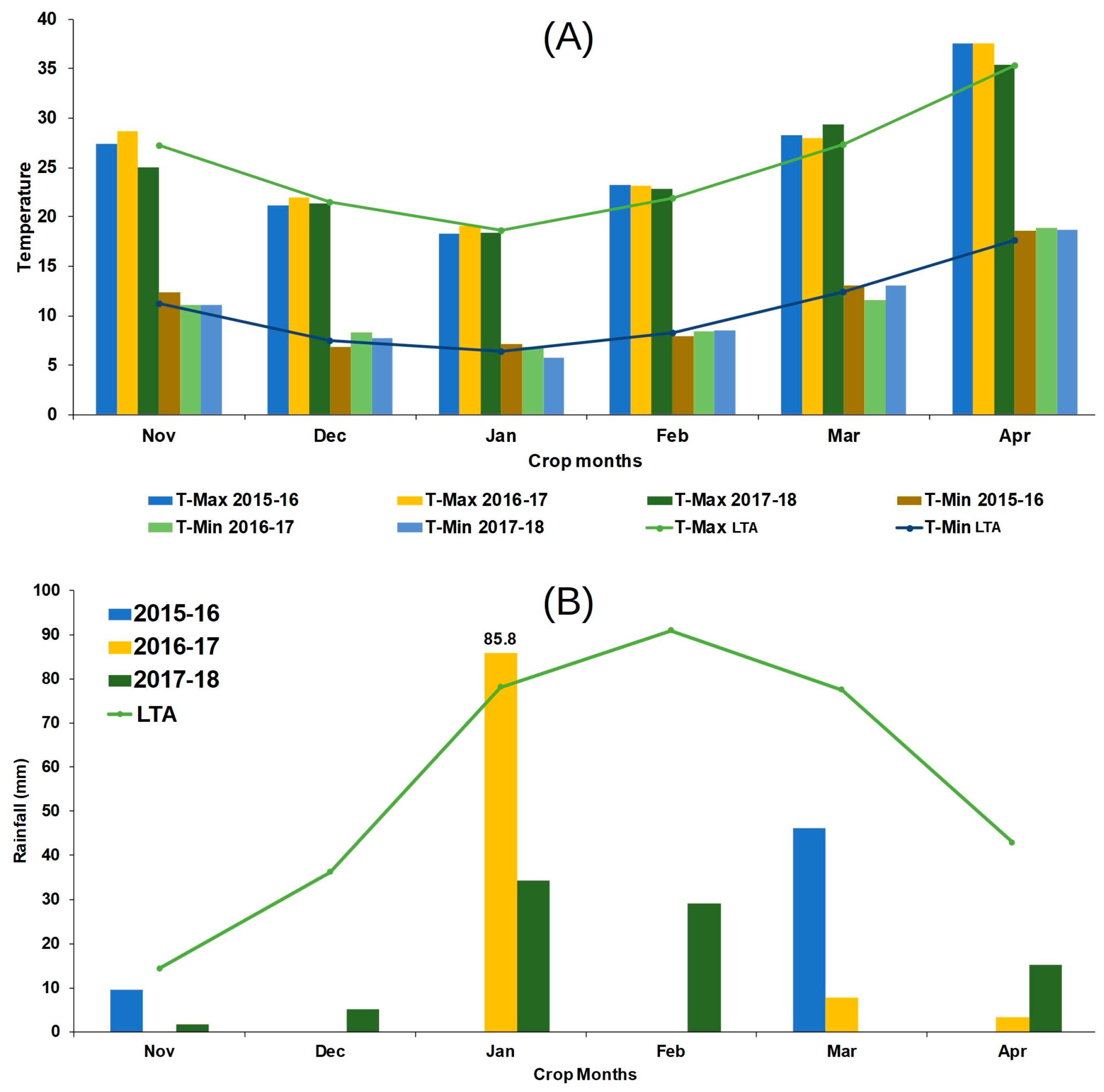
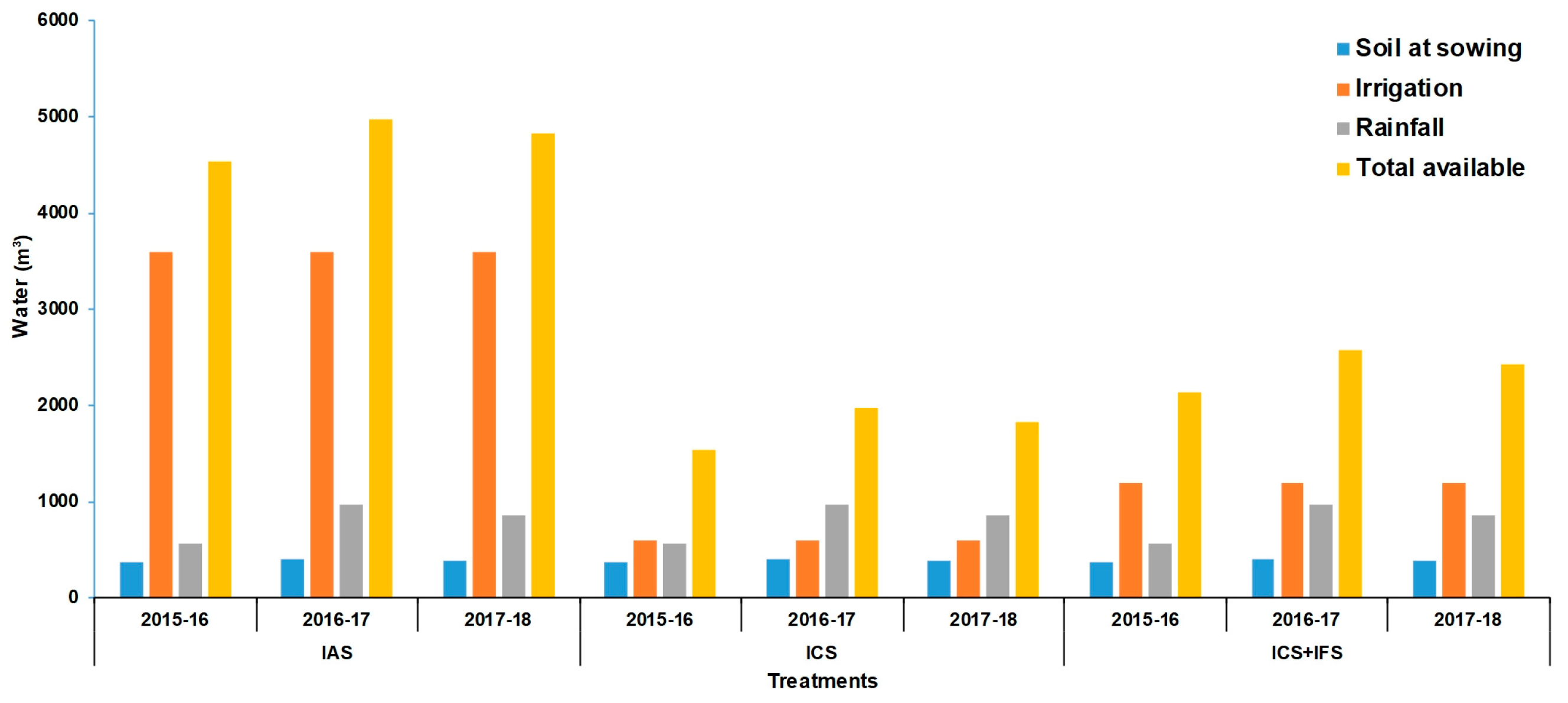
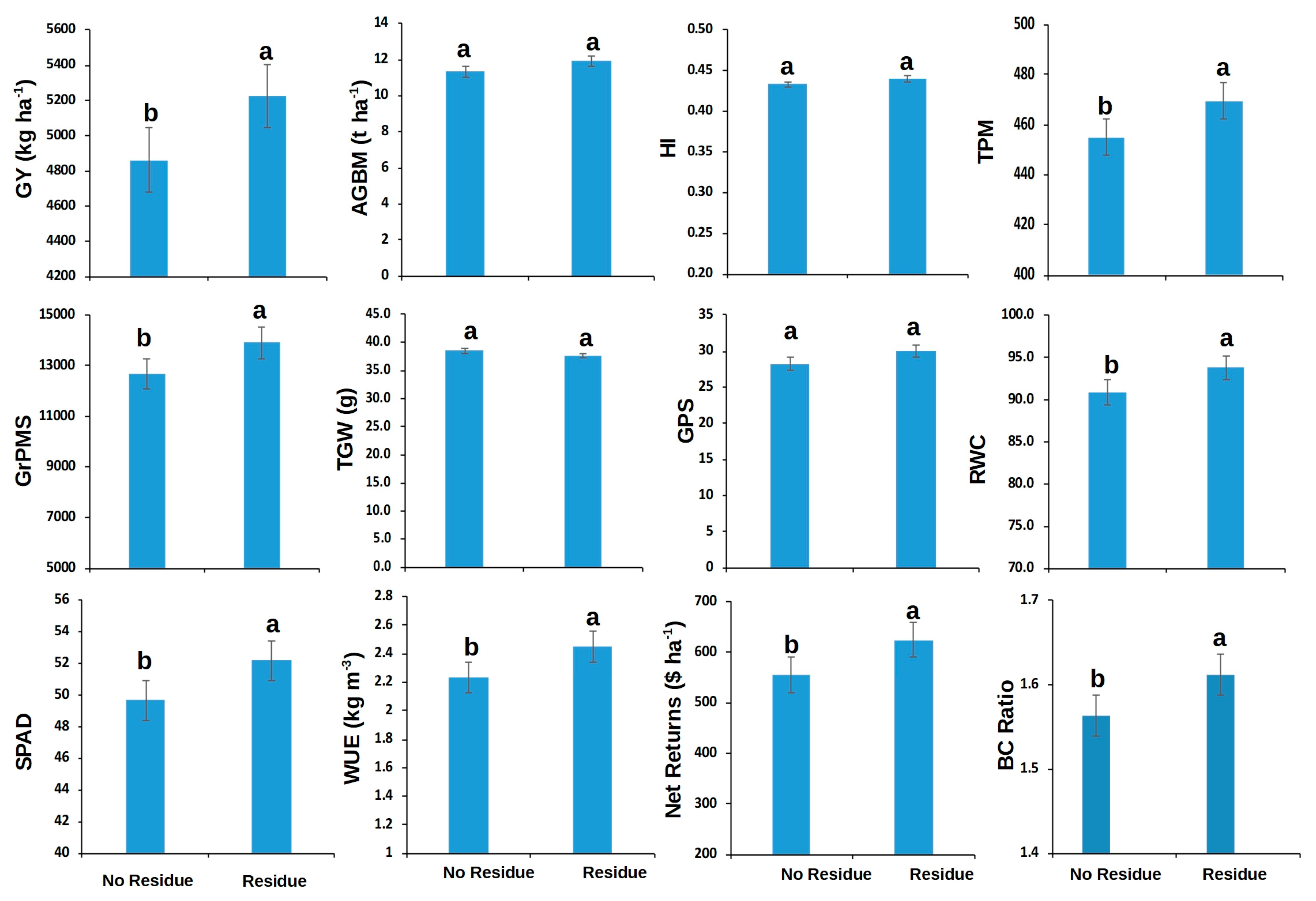
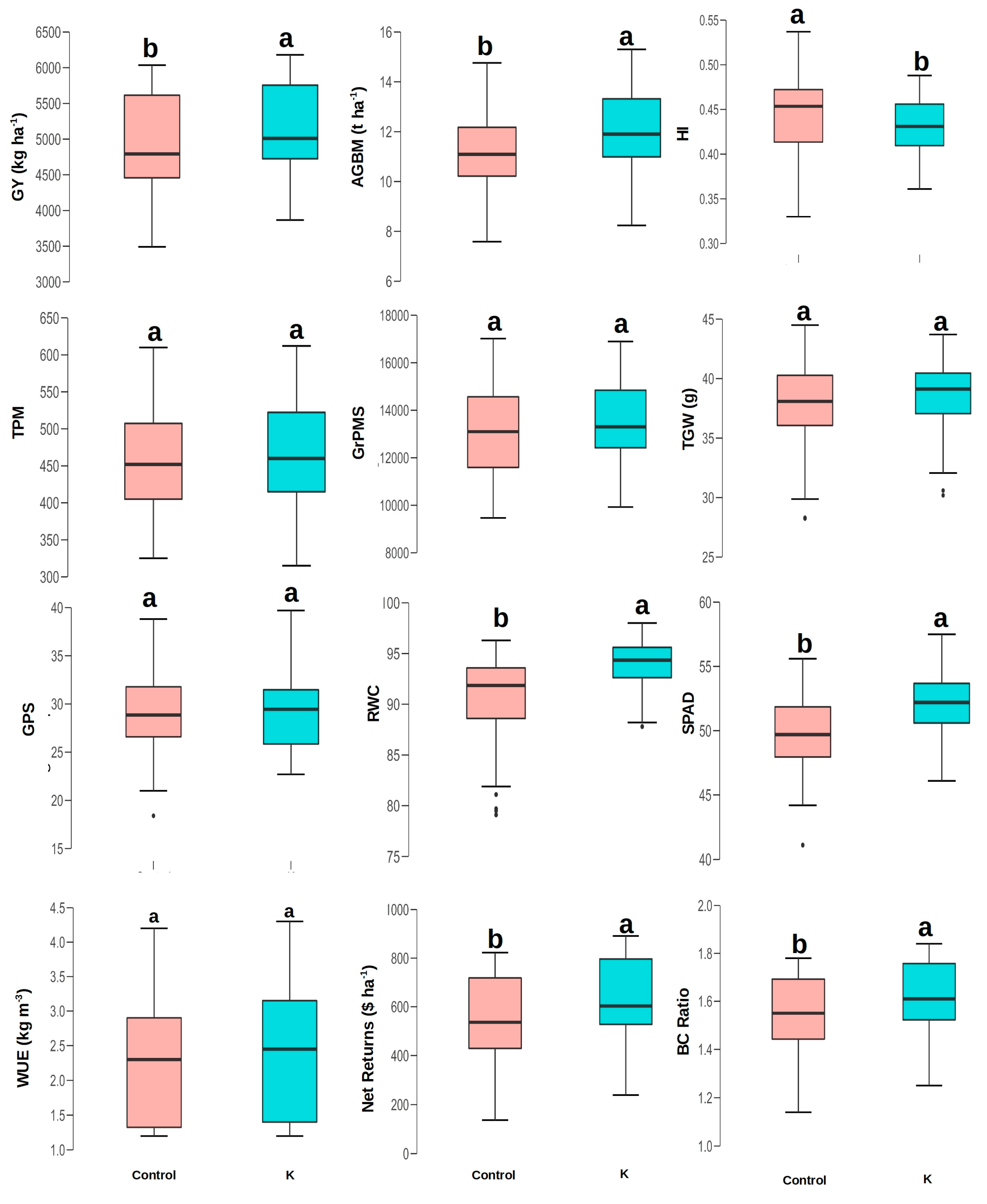
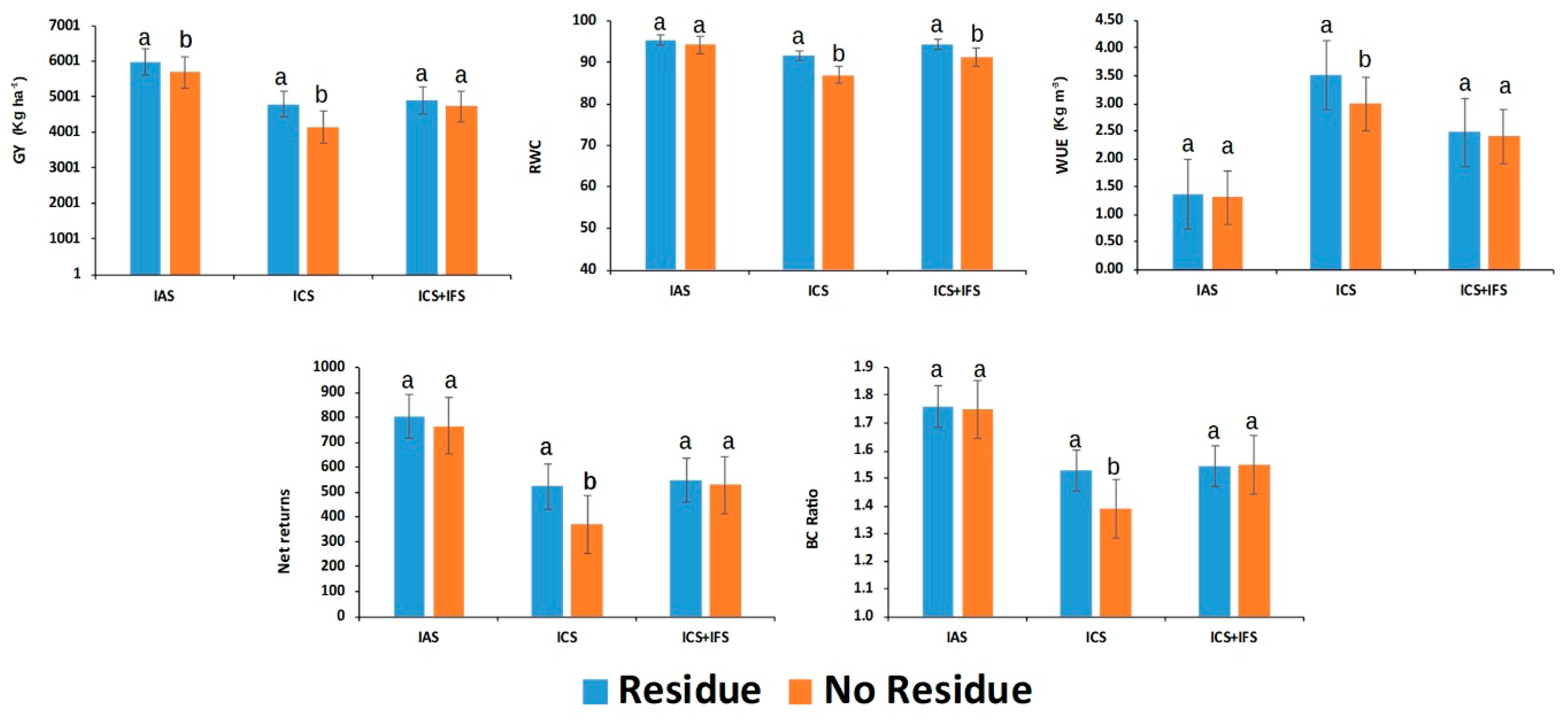
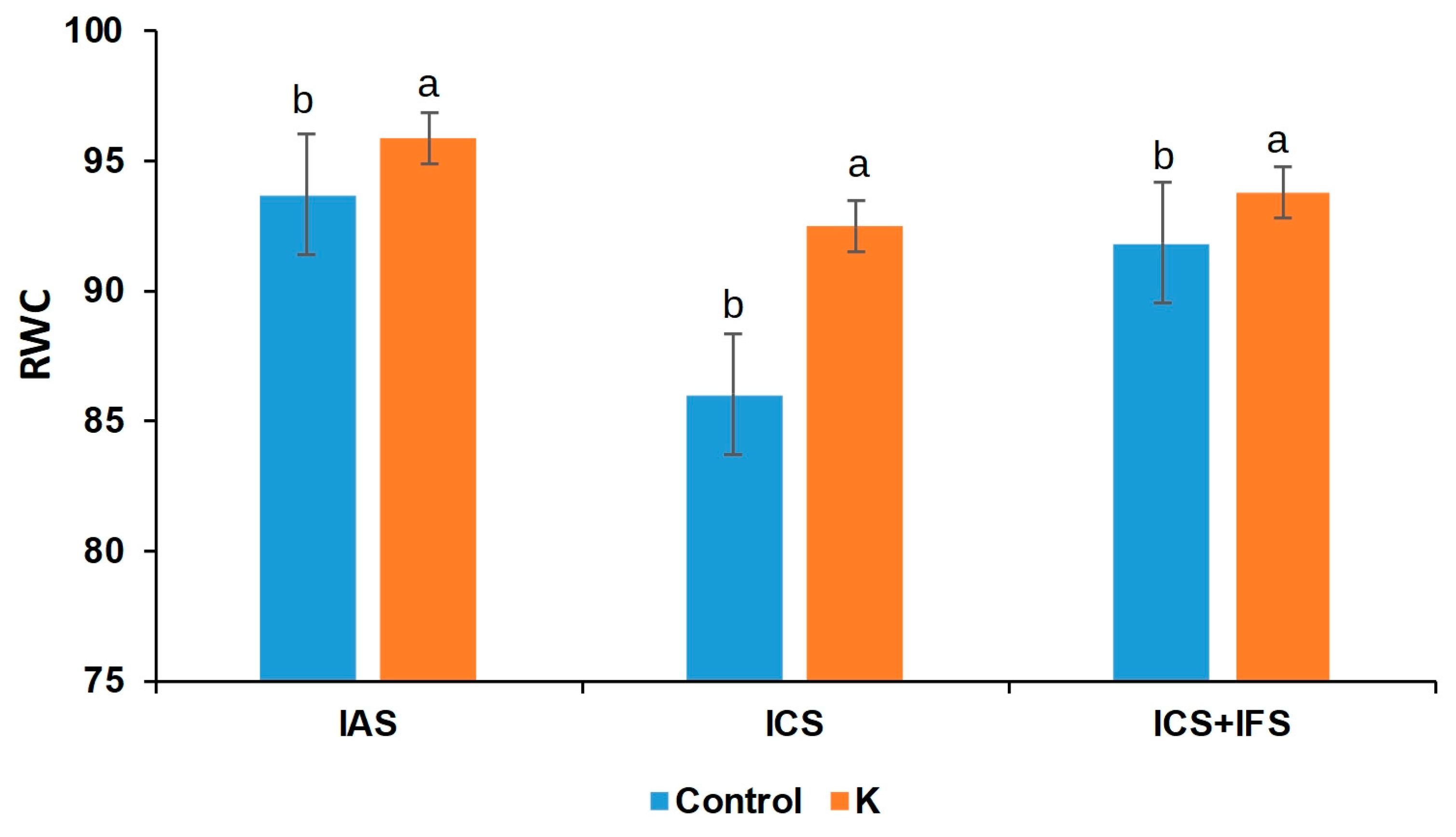
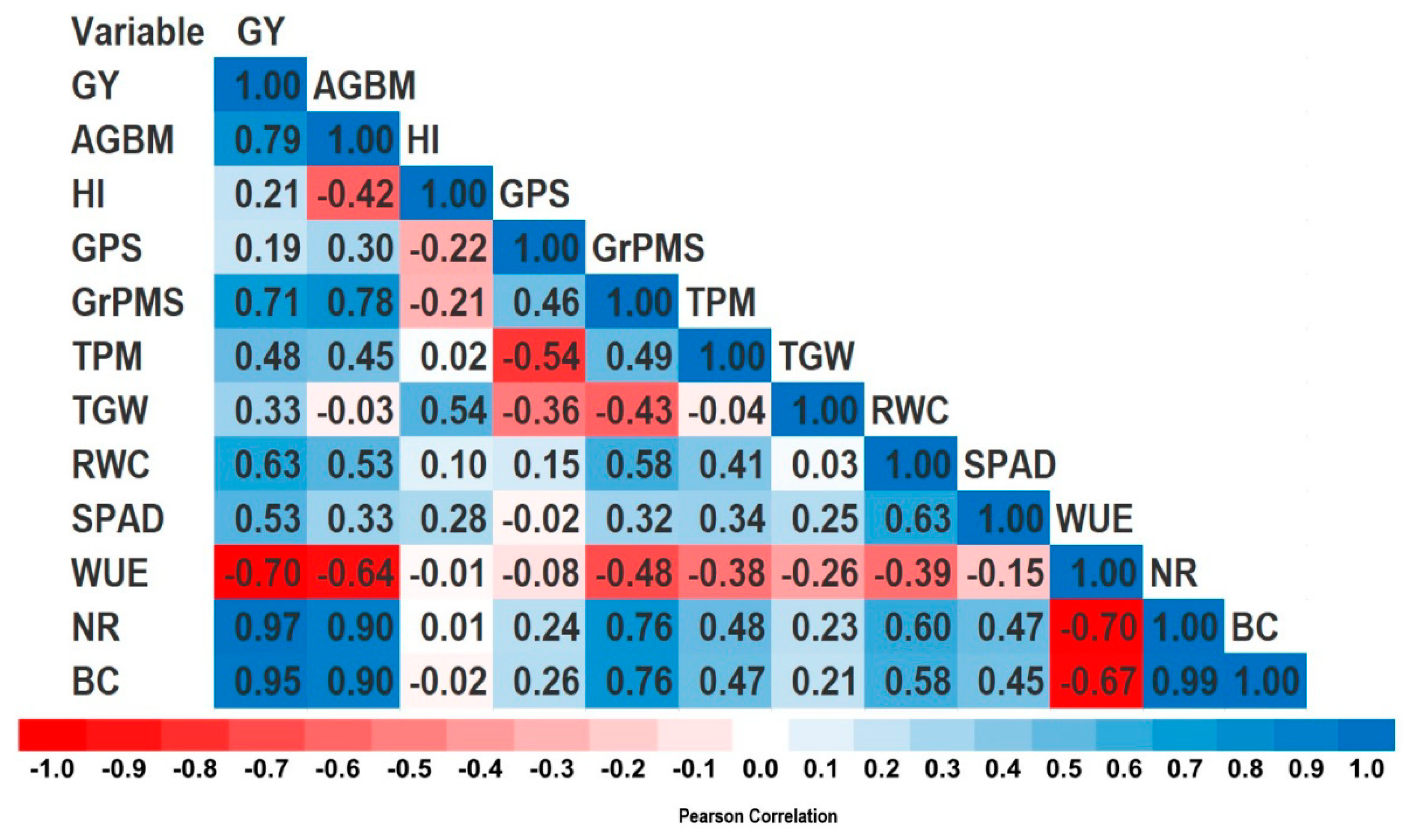
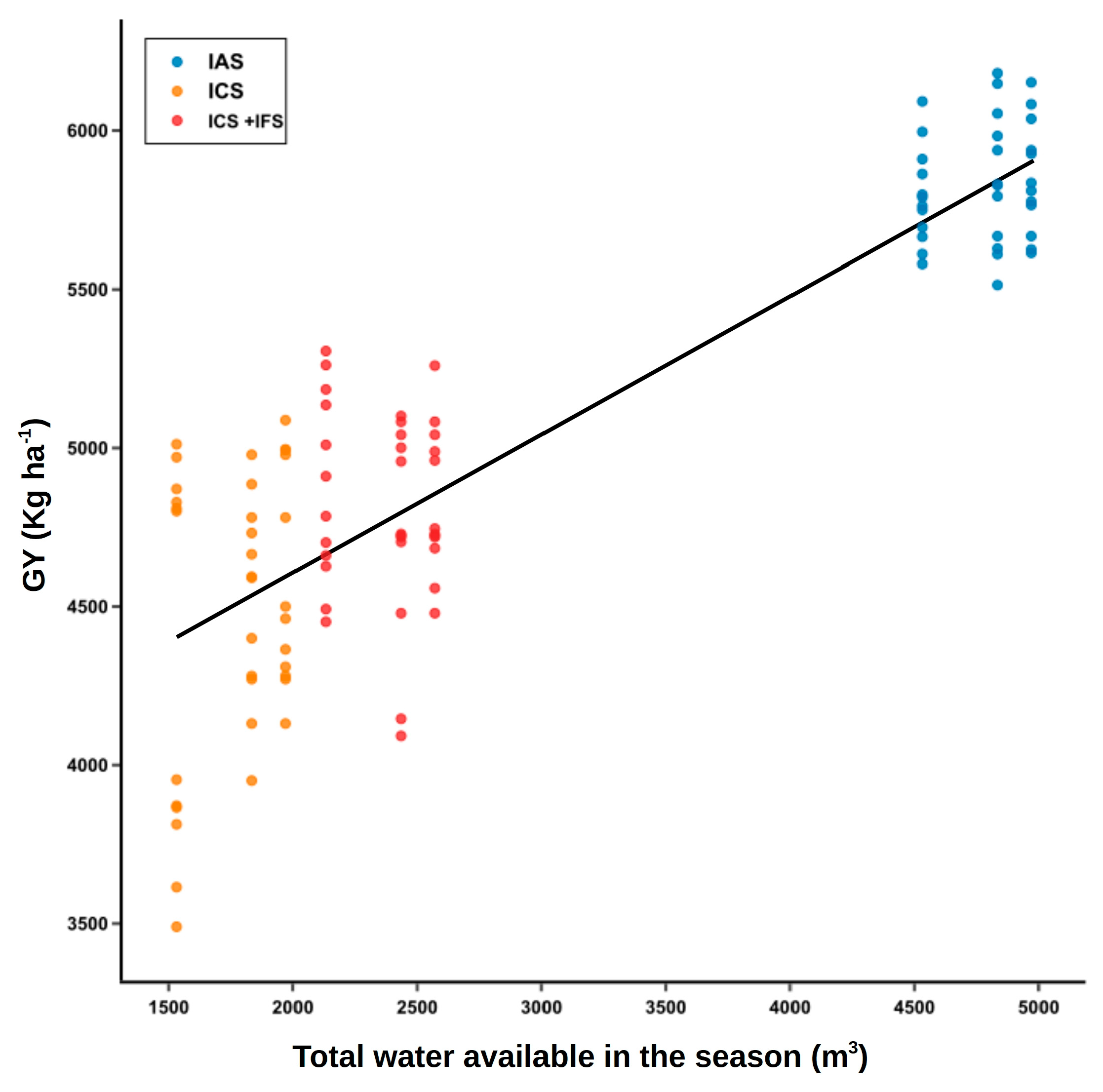
| Effect | df | GY | AGBM | HI | TPM | TGW | RWC | SPAD | GPS | GrPMS | WUE | Net Returns | BC Ratio |
|---|---|---|---|---|---|---|---|---|---|---|---|---|---|
| Residue (R) | 1 | <0.001 | 0.004 | 0.35 | 0.202 | 0.241 | <0.001 | <0.001 | 0.031 | <0.001 | <0.001 | <0.001 | <0.001 |
| Irrigation levels (I) | 2 | <0.001 | <0.001 | 0.135 | <0.001 | <0.001 | <0.001 | <0.001 | 0.554 | <0.001 | <0.001 | <0.001 | <0.001 |
| Foliar spray of K (K) | 1 | <0.001 | <0.001 | 0.121 | 0.166 | 0.304 | <0.001 | <0.001 | 0.791 | 0.194 | 0.033 | <0.001 | <0.001 |
| R × I | 2 | <0.001 | 0.308 | 0.277 | 0.713 | 0.386 | <0.001 | 0.438 | 0.683 | 0.097 | 0.002 | <0.001 | <0.001 |
| R × K | 1 | 0.757 | 0.871 | 0.689 | 0.669 | 0.718 | 0.075 | 0.769 | 0.963 | 0.510 | 0.772 | 0.899 | 0.788 |
| I × K | 2 | 0.451 | 0.334 | 0.092 | 0.418 | 0.726 | <0.001 | 0.287 | 0.553 | 0.430 | 0.495 | 0.942 | 0.916 |
| R × I × K | 2 | 0.749 | 0.555 | 0.280 | 0.304 | 0.836 | 0.039 | 0.592 | 0.627 | 0.956 | 0.972 | 0.981 | 0.978 |
| Effect | Sum of Squares | df | Mean Square | F | p |
|---|---|---|---|---|---|
| Residue retention (R) | 1,557,000 | 1 | 1,557,000 | 30.882 | <0.001 |
| Irrigation levels (I) | 825,488.099 | 2 | 412,744.049 | 8.188 | <0.001 |
| Foliar spray of K (K) | 1,298,000 | 1 | 1,298,000 | 25.749 | <0.001 |
| R × I | 2,469,000 | 2 | 1,234,000 | 24.487 | <0.001 |
| R × K | 8533.333 | 1 | 8533.333 | 0.169 | 0.682 |
| I × K | 35,144.019 | 2 | 17,572.009 | 0.349 | 0.707 |
| R × I × K | 70,535.389 | 2 | 35,267.694 | 0.7 | 0.499 |
© 2020 by the authors. Licensee MDPI, Basel, Switzerland. This article is an open access article distributed under the terms and conditions of the Creative Commons Attribution (CC BY) license (http://creativecommons.org/licenses/by/4.0/).
Share and Cite
Meena, R.P.; Venkatesh, K.; Khobra, R.; Tripathi, S.C.; Prajapat, K.; Sharma, R.K.; Singh, G.P. Effect of Rice Residue Retention and Foliar Application of K on Water Productivity and Profitability of Wheat in North West India. Agronomy 2020, 10, 434. https://doi.org/10.3390/agronomy10030434
Meena RP, Venkatesh K, Khobra R, Tripathi SC, Prajapat K, Sharma RK, Singh GP. Effect of Rice Residue Retention and Foliar Application of K on Water Productivity and Profitability of Wheat in North West India. Agronomy. 2020; 10(3):434. https://doi.org/10.3390/agronomy10030434
Chicago/Turabian StyleMeena, Raj Pal, Karnam Venkatesh, Rinki Khobra, S. C. Tripathi, Kailash Prajapat, R. K. Sharma, and G. P. Singh. 2020. "Effect of Rice Residue Retention and Foliar Application of K on Water Productivity and Profitability of Wheat in North West India" Agronomy 10, no. 3: 434. https://doi.org/10.3390/agronomy10030434
APA StyleMeena, R. P., Venkatesh, K., Khobra, R., Tripathi, S. C., Prajapat, K., Sharma, R. K., & Singh, G. P. (2020). Effect of Rice Residue Retention and Foliar Application of K on Water Productivity and Profitability of Wheat in North West India. Agronomy, 10(3), 434. https://doi.org/10.3390/agronomy10030434





